
Italian torpedo boat Premuda was a 1916 Type Large Torpedo Boat of the Imperial German Navy during World War I. Built as SMS V116 she was the first ship of her class to be launched.

The French destroyer Amiral Sénès was a 1916 Type Large Torpedo Boat of the Imperial German Navy during World War I. Built as SMS S113 she was the first ship of her class to be laid down, but the second and final ship of her class to be launched.
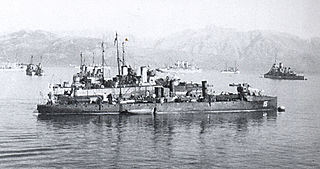
SMS Boa was a torpedo boat of the Austro-Hungarian Navy. Built as a unit of the Cobra class, she was typical of the seagoing torpedo boats acquired by Austria-Hungary between 1896 and 1914. In 1910 she was renamed Torpedoboot 15.
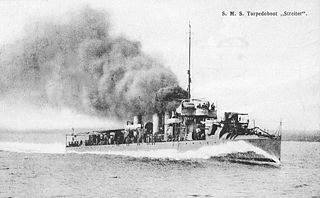
The Huszár class was a class of destroyers built for the Austro-Hungarian Navy before the First World War. They were built to a design by the British shipbuilder Yarrow Shipbuilders, who built the first ship, with a further 11 ships being built in Austrian and Hungarian yards between 1905 and 1909. A replacement ship was built when the lead ship was lost in an accident in 1908, and another ship of similar design building for the Chinese navy was seized on the outbreak of the First World War. Two ships were lost during the war, a single ship serving with the Greek Navy following the end of the war, and the remainder being scrapped.
The Sirio class was a class of six sea-going steam-powered torpedo boats of the Italian Regia Marina built by the German shipyard Schichau-Werke from 1904–1906. They served in the Italo-Turkish War and the First World War.
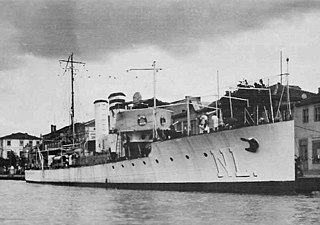
NMS Năluca was a torpedo boat of the Royal Romanian Navy. She was commissioned in 1920, after initially serving as Tb 82 F in the Austro-Hungarian Navy during World War I. She and six more sister ships were awarded to Romania as reparations after the war ended.

SMS S90 was a torpedo-boat of the Imperial German Navy. She was built by Schichau at Elbing as the lead ship of her class, completing in 1899.
SMS S116 was a S90-class torpedo boat of the Imperial German Navy that served during the First World War. The ship was built by Schichau at Elbing in Prussia, and was completed in March 1903. The ship was torpedoed and sunk by the British submarine E9 on 6 October 1914.

The Trad class was a class of nine torpedo boats built for the Royal Thai Navy in the 1930s by the Italian shipbuilder Cantieri Riuniti dell'Adriatico. They entered service between 1935 and 1938. Two of the ships were sunk (and a third badly damaged by French warships at the Battle of Ko Chang in 1941, but the remaining seven ships had long careers, remaining in service until the 1970s.

The Cobra class was a class of four torpedo boats built by the British shipbuilder Yarrow for the Austro-Hungarian Navy in the late 1890s. All four ships served through the First World War and were scrapped in 1919.

SMS Viper was a torpedo boat of the Austro-Hungarian Navy. Viper was built by the British shipbuilder Yarrow between 1895 and 1896 and formed the basis for the following Cobra-class torpedo boats. She was renamed Torpedoboot 17 in 1910 and served through the First World War as a patrol boat and minesweeper. She was scrapped in 1920.
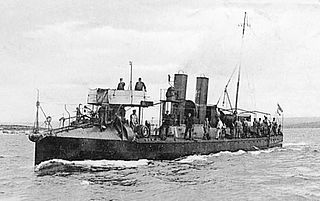
The 110t class were a class of twelve coastal torpedo boats built for the Austro-Hungarian Navy between 1909 and 1911. They were built by two shipbuilders, the Austrian Stabilimento Tecnico Triestino and the Hungarian Ganz & Danubius, with six ships built each. They served through the First World War, with one of the ships, Tb 11, defecting to Italy in 1917. After the end of the war, several of the class were used by the Italian Navy and the Italian Customs Service, with the last example scrapped in 1926.

Sokol was the first torpedo boat destroyer built for the Imperial Russian Navy. She was designed and built by the British shipbuilder Yarrows from 1894 to 1895 and was claimed to be the fastest warship in the world during her sea trials. She was renamed Pruitki in 1902.
SMS S14 was a V1-class torpedo boat of the Imperial German Navy. She served with the German High Seas Fleet at the start of the First World War, and was sunk by an internal explosion on 19 February 1915.

SMS S18 was a V1-class torpedo boat of the Imperial German Navy. The ship was built by Schichau-Werke, at their Elbing shipyard, completing in 1912. S18 served with the German High Seas Fleet during the First World War, taking part in the Battle of Jutland in 1916. S18 survived the war, serving in the Weimar Republic's Reichsmarine. She was scrapped in 1935.
SMS S21 was a V1-class torpedo boat of the Imperial German Navy. The ship was built by Schichau-Werke, at their Elbing shipyard, completing in 1913. S21 served with the German High Seas Fleet during the First World War, and sank following a collision with the cruiser Hamburg on 21 April 1915.
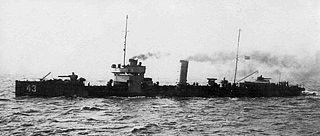
SMS S143 was a S138-class large torpedo boat of the Imperial German Navy. The S138-class were large torpedo boats that were required to reach a speed of 30 kn and armed with three 45 cm torpedo tubes. S143 was built by the Schichau-Werke at Elbing and was launched on 6 April 1907, entering service later the same year.

SMS G133 was a S90-class torpedo boat of the Imperial German Navy. G133 was built by the Germaniawerft shipyard at Kiel in 1905–1906, being launched on 30 June 1906 and entering service at the end of that year.

SMS G134 was a S90-class torpedo boat of the Imperial German Navy. G134 was built by the Germaniawerft shipyard at Kiel as part of the 1905 construction programme, being launched on 23 July 1906 and entering service in March 1907.
SMS S51 was a torpedo boat of the Imperial German Navy. She was built in 1889–1890 by Schichau at Elbing, as one of a large number of small torpedo boats of similar design built for the German navy. S51 was renamed T51 in 1910, and served as a minesweeper during the First World War, and was mined and sunk in the Baltic on 29 May 1915.














